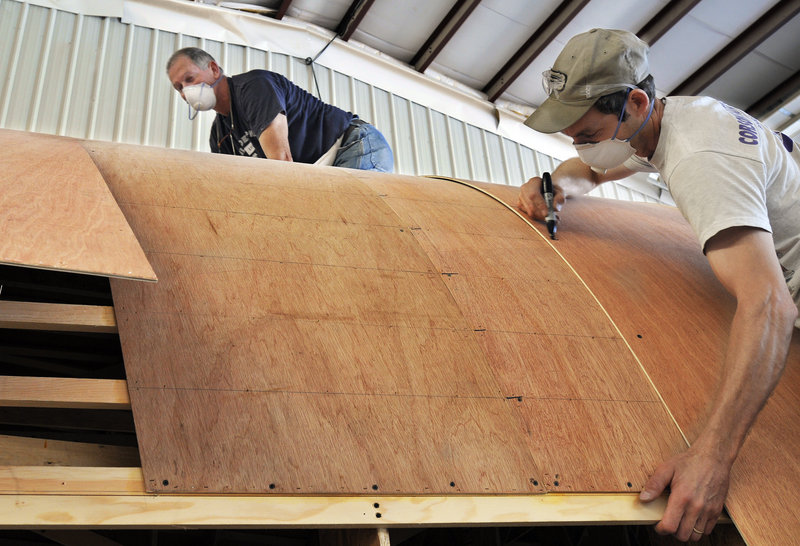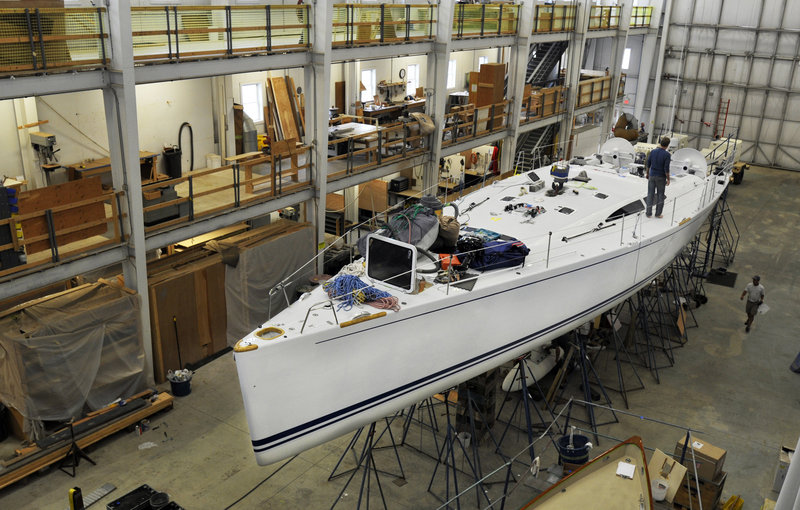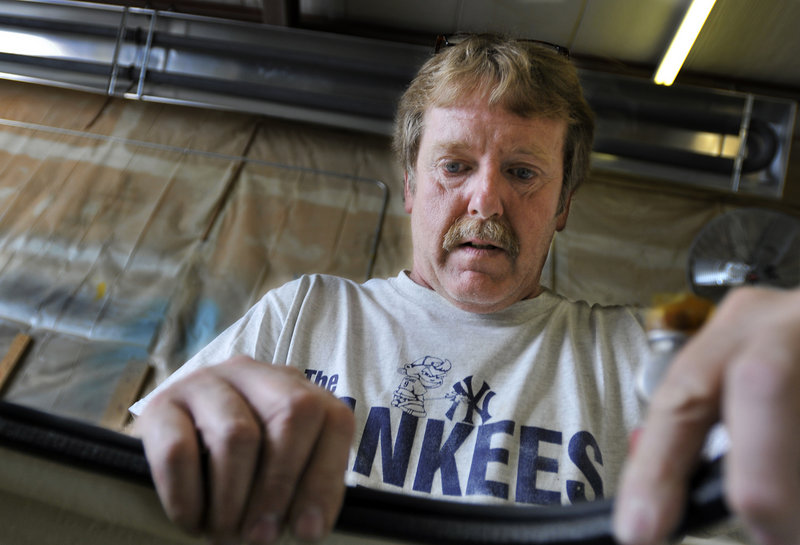THOMASTON – Sailor Jean DeFontenay watched last week as workers prepared to reattach a metal ballast ball to the keel of his 62-foot sailing yacht the Baraka, which rested on wooden blocks and steel stands inside a sprawling garage near the St. George River in Thomaston.
DeFontenay had brought his ship, which needed maintenance, back to Lyman-Morse Boatbuilding, the yard that built and launched the Baraka in 2006.
“There’s not many yards that can build boats like this,” explained DeFontenay, a Frenchman living in Connecticut who has sailed the Baraka through the Caribbean and across the Atlantic Ocean.
The heyday of shipbuilding in coastal Maine has long passed, but Lyman-Morse continues launching custom yachts like the Baraka in Thomaston.
And thanks to a recent restructuring and a foray into solar power, the company has weathered a recession that battered the marine industry.
Still, boatbuilding remains the core of the company, which has some 90 employees and annual revenue of about $18 million.
“If you want to build a high-end boat in the U.S. and you don’t call us, you haven’t done your homework,” said Cabot Lyman, 67, owner and CEO.
A longtime sailor who has circumnavigated the globe, Lyman launched Lyman-Morse with eight employees in 1978, when he bought land owned by the Morse Boatbuilding Co.
Initial projects included converting 46-foot lobster boat hulls into yachts and building 44-foot Seguin cruising sailboats.
In the last 30 years, Lyman-Morse has launched nearly 100 vessels, most ranging from roughly 25 feet to 60 feet in length.
The company makes sleek ocean-going sailboats like the Baraka and high-end motor cruisers like the 55-foot Whistler, which has twin jet-drive engines and can be controlled from the bridge with a computer mouse.
In 2006, the company launched its largest boat, the 94-foot motor cruiser Electra, which has twin 2,200-horsepower engines and cruises at 27 knots.
Marine architects design the hulls, and Lyman-Morse builds the boats. The process starts when the company’s drafters and designers use computer software to create digital three-dimension models. They also lay out the cabins, many of which are trimmed with mahogany, and map each boat’s electrical and mechanical systems.
“Everything you do on a custom boat is new and has never been done before,” Lyman said. “That’s what makes it fun.”
After the boats are designed, workers create full-scale, plywood mock-ups to help visualize the finished product. Customers inspect the mock-ups, and often suggest changes.
Next, Lyman-Morse makes molds, which are used to create the major fiberglass components, like the hull and deck. The boats take shape once the fiberglass is laid.
Last week, workers sanded the underside of the fiberglass deck of a 63.5-foot sailing yacht under construction. The customer who ordered the boat, Lyman said, plans to sail it alone around the world.
Lyman-Morse also sells a host of other marine services, including sail rigging, metal fabrication, varnishing, painting and canvas and cabinet work.
The pinnacle years for Lyman-Morse were those leading up to the recent recession, when the boat business boomed.
“Everybody was getting spoiled,” Lyman said of the period, when the company had more than 200 employees, $22 million in revenue and finished three or four boats a year.
In 2006, Lyman-Morse purchased a million-dollar, 110-ton travel lift boat hoist. The next year the firm completed work on a $4 million, 22,400-square-foot building. The 55-foot-tall structure can accommodate boats longer than 140 feet.
Then the recession hit, and boat sales across the industry plummeted.
According to data from trade group National Marine Manufacturers Association, 146,630 new traditional power and sail boats (excluding personal watercraft, canoes and kayaks) were sold in the United States in 2010, down 55 percent from a high of 327,100 in 2005.
The value of those sales dropped 50 percent during the period, from $10.2 billion in 2005 to $5.18 billion in 2010.
Recreational powerboat sales and marine accessory sales in Maine totaled $84.5 million in 2010, down 62 percent from $221.2 million in 2005, according to the group.
Susan Swanton, executive director at the Maine Marine Trades Association, said Maine boatbuilders “took a hit as hard, if not harder, than everybody else.”
Other boatbuilders in Maine include custom shops like John Williams Boat Company, Wilbur Yachts, Atlantic Boat Company, Brooklin Boat Yard, Rockport Marine and Ellis Boat Company.
Maine is also home to higher-production builders like Kenway Corp., Saber Yachts Corp., Hinckley and Morris Yachts.
Lyman responded to the recession by restructuring the company. He cut the work force to about 90 employees, hired project managers and gave them decision-making authority and upgraded the company’s financial management software.
In the last few years, the firm’s revenue dropped nearly 20 percent to an expected $18 million in 2011, but Lyman said profits remain high.
“It’s a tough market out there,” he said, noting that very few customers are ordering new boats. “Building a brand-new custom boat right now is a rarity. The days have gone by when we are all busy.”
But workers aren’t sitting still. Lyman said the firm’s service yard remains busy, generating 60 percent of revenue, up from about 40 percent a few years ago.
Also, Lyman-Morse diversified outside the marine market. For instance, the metal fabrication shop now helps construct buildings.
A few years ago, Lyman-Morse began building Powercubes, portable solar-energy generators that now account for about 10 percent of revenue.
Retractable solar panels fold out of the refrigerator-size units, which cost about $25,000 and provide enough juice to power a small office.
Customers include the U.S. Army, which ships them to forward bases in Iraq and Afghanistan.
Lyman said entering the solar market was a natural transition. “We have been designing AC/DC power systems for years,” he said. “We are as good at it as anyone in the world.”
But boatbuilding remains at the company’s core, and Lyman called the firm’s Maine heritage one of its greatest assets.
“If (I) say I am a Maine boatbuilder, I get a lot of respect around the world,” he said.
Lyman added that he wishes Maine’s government would take more interest in the state’s marine industry — perhaps even partner with boatbuilders to promote the sector, as other governments have done.
For instance, he said, New Zealand government officials travel with builders to boat shows worldwide promoting the islands’ boatbuilding heritage.
“We are a bigger business than anybody thinks,” Lyman said of Maine’s marine industry, noting that Lyman Morse’s infrastructure, including roughly a dozen buildings, is worth about $8 million. “We bring business right back into the economy.”
Jonathan Hemmerdinger can be reached at 791-6316 or:
jhemmerdinger@mainetoday.com
Send questions/comments to the editors.





Success. Please wait for the page to reload. If the page does not reload within 5 seconds, please refresh the page.
Enter your email and password to access comments.
Hi, to comment on stories you must . This profile is in addition to your subscription and website login.
Already have a commenting profile? .
Invalid username/password.
Please check your email to confirm and complete your registration.
Only subscribers are eligible to post comments. Please subscribe or login first for digital access. Here’s why.
Use the form below to reset your password. When you've submitted your account email, we will send an email with a reset code.